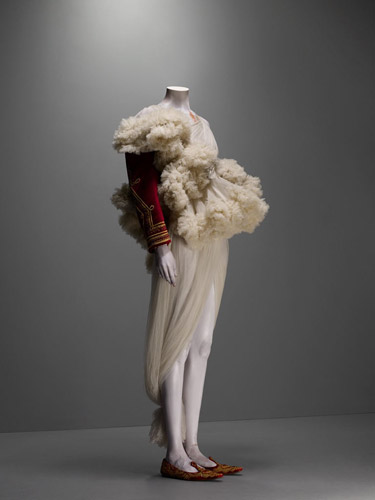Alexander McQueen is the type of designer who inspires very strong emotions in both his advocates and detractors. Regardless of whether you love him or hate him, however, there's no denying the fact that Alexander McQueen: Savage Beauty, on display now through August 7 at the Metropolitan Museum of Art, is a spectacle worth attending.
The most interesting thing about seeing McQueen's entire life's work - about 100 pieces from a 19 year career - in one place, is to really able to experience the breadth of his range and the evolution of his vision. The theme of Savage Beauty is romanticism, and it's very accurate to say that McQueen was a Romantic in the, 18th-century English sense of the word. McQueen's entire career was based on aesthetics and playing the the ideas of opposites - beauty and ugliness, light and dark - and he was always attempting to push the boundaries of what was considered appropriate and expected for a fashion designer. Savage Beauty plays upon these concepts and expands upon the romantic theme with six different categories: The Romantic Mind, Romantic Gothic and Cabinet of Curiosities, Romantic Nationalism, Romantic Exoticism, Romantic Primitivism, and Romantic Naturalism. Each room holds a different theme, set of collections and sensory experience, but each is unmistakably, fantastically, redolent of McQueen's spirit and enduring appeal.
Romantic Gothic and Cabinet of Curiosities. Courtesy of the Metropolitan Museum of Art, New York.
The thing about McQueen's work is that the fashion itself is only one element in what were incredibly intricate, theatrically inclined fashion shows. The exhibition acknowledges this fact not only by creating very different environments within which his designs are displayed, but by creating a very particular mood for each room with lights and music, and even by featuring excerpts from some of the shows themselves. This last method was particular interesting to me, both because I had never seen any of the original fashion shows before and because it lends so much more depth to the clothing; as interesting as each piece is alone, it's a completely different thing to see the collections in context. For example, for Romantic Gothic and Cabinet of Curiosities, a room which nicely embodies its Victorian Gothic theme, televisions both broadcast clips from these shows and add an appropriately eerie touch. In another room, a hologram of Pepper's Ghost from the Windows of Culloden collection (autumn/winter 2006-07) is surrounded by visitors transfixed by this miniature floating, temporal apparition.
Alexander McQueen, Ensemble, The Girl Who Lived in the Tree collection, autumn/winter 2008–9. Jacket of red silk velvet embroidered with gold bullion and trimmed with white shearling; dress of ivory silk tulle. Photography by Sølve Sundsbø. Courtesy of Alexander McQueen and the Metropolitan Museum of Art, New York.




No comments:
Post a Comment
Thanks for your comments - they mean the world to me!